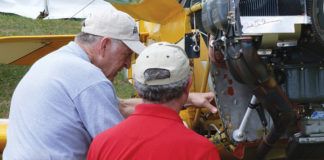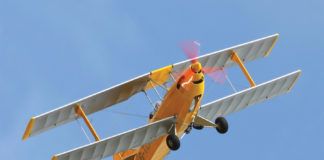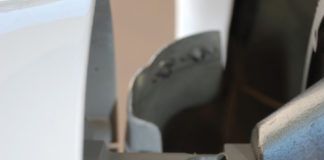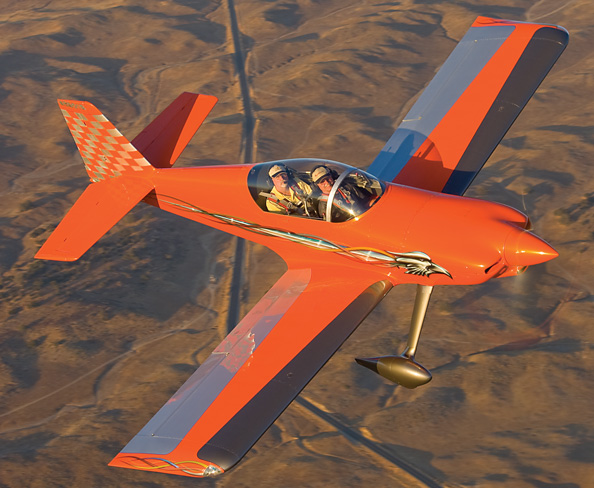
You get the vibe as soon as the door to Dick Johnson’s hangar creaks to the roof. In front of you is a sea of Harley orange, a hue when allied with jet black and displayed as both point and counterpoint, in great unbroken swaths and as a checkered flag, gives the unmistakable impression of a man who has found his theme. Look beyond the centerpiece of the hangar and you’ll see a Harley-Davidson FXR motorcycle, a refurbished Harley golf cart, and a shop area so neat, so well organized that you want to set fire to your own and move in full time.
But you will not have seen past that centerpiece, a matching Tangelo-hued F-1 Rocket. Your gaze will tone-lock onto the chrome-effect eagle’s head airbrushed onto the Rocket’s flanks, for sure, and you’ll undoubtedly allow yourself to follow its streamer-wrapped body back to the checkerboard tail. Bright. Splashy. Oh…so shiny!
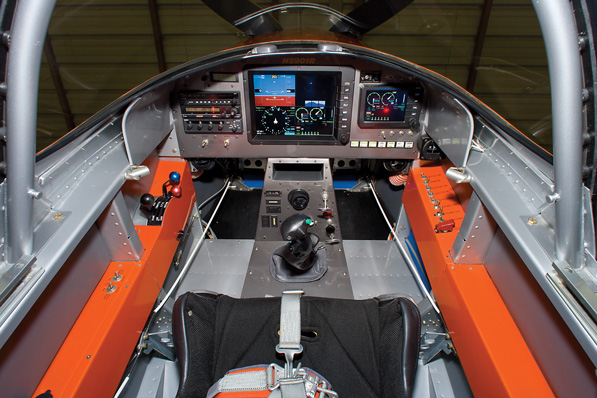
Well, yes. Pull up a stool and begin looking at the quality of this project, and you’ll eventually be aware of visual sleight of hand taking place right under your nose. See the silver-gray canopy bow? It helps create the partial illusion of a one-piece bubble—much more effective than painting it orange or black. Did you notice the dark-hued gear legs and unadorned wheelpants? The purpose here is to make them visually disappear, and in the right light, they do. Step up to Johnson’s open-air loft at the back of the hangar to see another clever ploy at work. The dark leading and slightly lighter trailing edges of the wing contrast with the Tangelo—that’s the official House of Kolor paint name, an extraordinarily popular Harley hue—center section. The result? The orange pops out, making this Rocket appear to have a tapered wing. The design on the wingtip is intended to evoke a fighter-jet’s tip tank.
“Wow,” you say out loud. “Wow.” So, too, did the judges at the 2009 Copperstate Fly-in, who awarded this airplane best-in-show honors. That sound you hear is the buffing machine coming out in preparation for a trip to Sun ’n Fun or Oshkosh this year.
Beneath the Skin
Constructed over the course of eight years and 6500 hours, N5901R is, believe it or not, the product of two first-time builders. Dick Johnson and his building partner, fabricator and aerospace welder to the stars, LeRoy Jensen, began the project not because they were intent on building for building’s sake. Johnson, who had retired from airline flying, was looking for a fast personal airplane. “I really wanted something that would do 3 miles a minute [180 knots]. That seemed a nice round performance number. We first started looking at production airplanes, but I didn’t see anything I really was too excited about. I made offers on a couple, which didn’t go through, and I’m now glad they didn’t.”
Coming to the F-1 Rocket, Johnson and Jensen brought with them years of fabricating and hot-rodding experience. “We’re both kinda gearheads,” Johnson says as the soft-spoken Jensen nods and smiles. “Between us, we’ve done all sorts of projects, ’57 Chevys, ’65 Corvettes, a Pantera, motorcycles, you name it.”
So an airplane is a reasonable next leap of logic, eh? “We didn’t think much about it,” Johnson says. “It looked like a lot of fun, and I figured that I could afford to continue flying after retirement if I could build something myself. I chose the Rocket because it had the style I wanted and was all metal. I wasn’t interested in a fiberglass airplane.” He concludes that statement with the kind of been-there/done-that shrug.
A Philosophy Unstated
Spend a few hours in the company of these men and their airplane, and you sense a quiet confidence. But that confidence is definitely backed up by challenges in the build itself. “The build was quite a learning process. LeRoy had a lot experience with metal already and was a Class I welder. It was easier for him to catch on than it was for me. Team Rocket said the build time was 1200 hours. Well, I have a documented 4300 hours on the project, and LeRoy has 2200 hours,” Johnson says, though he admits that quite a lot of that time has to do with getting the Rocket “just right.” And it shows.
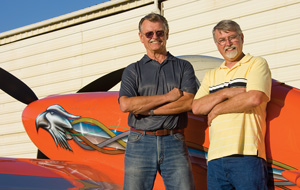
That paint job we’ve been drooling over? Johnson’s own work. He did farm out the airbrush work, but the prep and base coats bear his signature. Likewise the layout and application of the checkerboard on the tail. “That’s harder than it looks,” he says, somewhat ruefully. Try to find a blemish, a paint sag or a run…go ahead, we’ll wait.
A large part of this airplane’s story centers on the custom aspects—and here you can see the residue of Johnson and Jensen’s fascination with custom cars and motorcycles, and their proven inability to leave good enough alone. (We rode to lunch in Dick’s “daily driver” SUV that had big wheels, a rumbly exhaust and what felt like anything-but-stock suspension. Getting the picture?)
Twist the Camlok fasteners, lift the cowl and behold the engine, a custom overhaul of a Lycoming IO-540. Slightly conservative by nature, Johnson built the engine with stock internal components, but it’s fed by an Airflow Performance fuel injection system through a Barrett Precision Engines magnesium cold-air induction system, which separates the intake plenum under the engine from the oil sump. The exhaust is a custom one-off by Jensen, made from 321 stainless steel and ceramic coated. “That was a lot of cut, fit and try,” says Jensen, whose welding prowess is plain to see. The exhaust is a three-into-one split system with nearly equal length primary tubes, a compact collector and a longish turndown final pipe. Here’s another clever touch that shows the builders’ truly custom-mindedness: Between the exhaust pipes and hanging from the lower engine-mount crossmember is a curious pair of chromed tubes whose proportion and outlets mirror the exhausts’. What are they for? How about the outlets for the sniffle valve and the fuel-pump diaphragm vent. And the mounting bracket has an ear molded on to hold a connector for an external battery charger. Clever, thoughtful, perfectly executed. (Confidence in your own building abilities just said “dang” for about the 90th time.)
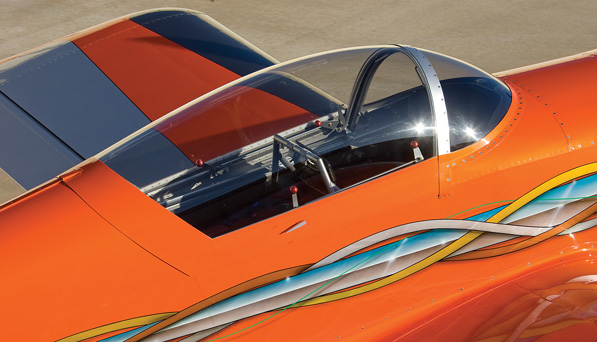
Ignition is from dual LightSpeed electronic systems—not a mag in sight. The engine is shrouded by a full plenum cooling system. Carbon-fiber inlets feed an aluminum housing. “Again, we spent a lot of time getting all the fiberglass [and carbon] to fit properly,” says Johnson. A Positech oil cooler is mounted to a bracket on the firewall, with the flanges of the cooler slotted so it can be removed more easily; it’s fed by a carbon scoop from behind the number-five cylinder that features an internal air splitter to improve efficiency. To make room for the Airflow Performance purge valve on the spine of the engine, Johnson and Jensen fabricated a reversing bellcrank that includes a safety spring. Should the linkage break, the valve will remain in or return to the “running” state.
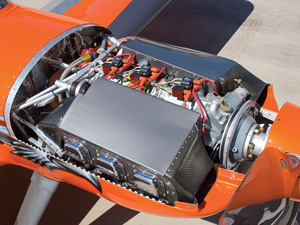
A three-blade, custom-painted Whirl-wind prop leads the way. For the propulsion package, Johnson chose the most modern exterior components—the outside-the-engine systems—mated to a proven core. Sure, you could coax more than 300 horsepower from a parallel-valve six-cylinder Lycoming with high-compression and porting, but this airplane is hardly hurting for performance and, besides, part of the 3-miles-a-minute requirement comes from the desire to travel, and that calls for day-in, day-out reliability. While it’s still early in the life of his airplane, Johnson is so far delighted with the firewall-forward aspects of the build.
Come Inside
While the two-place tandem cockpit is familiar to a lot of builders, a closer inspection reveals some cool alterations. For example, those seats aren’t run-of-the-mill aircraft parts. Nope, they’re car racing seats that have been lightened and modified to fit the airplane; they grip the human body like a kindly vise, which is what you want in such a responsive aircraft. Moreover, they’re mounted on slots and pins so that removing the front seat, for example, is about a 1-minute job, making access to the belly that much easier. The similarly sourced and equally cozy rear seat pivots forward to reveal the diminutive baggage area behind. All of the fittings, levers and pivots were fabricated from scratch by Johnson and Jensen. Five-point Hooker Harness seat belts are fitted to both seats, with pads that match the exterior color perfectly. The more of these details you witness, the more you’re likely to believe these guys stayed up late every night thinking it through, figuring out how to go just one step further.
Johnson chose what he thought was the best avionics suite available at the time, and has since come to be cautious of the Blue Mountain twin-screen system. Not that he’s had a lot of trouble, but the future support is very much in question. “I don’t know what I’ll do about that,” he says.
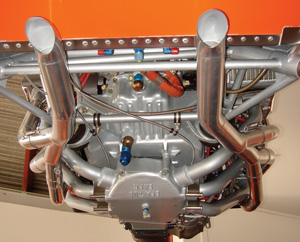
For navigation and communication, this Rocket depends on the Blue Mountain’s internal GPS, plus a Garmin SL30 nav/com, an Icom IC-A200 com radio, and Garmin GTX 320A transponder. The Blue Mountain includes an integrated two-axis autopilot. All of these components are run by a 24-volt electrical system whose motive power starts at a pair of Odyssey PC680 12-volt batteries wired in series. And here’s something every builder should keep in mind: Every wire in the airframe is marked at each terminus and often mid-run with a combination of shrink-on and adhesive-backed labels.
Enough Airplane For You?
Johnson has extensive flight experience, most all of it in heavy iron. “I learned to fly in the ROTC in a Cessna 150, then went into the Air Force to fly the T-37, T-38 and RF-4 jets. But most of my career has been with the airlines, flying mainly Boeing equipment. When we started the Rocket, I didn’t have much light-aircraft time. Maybe 100 hours.” To get up to speed, Johnson spent 30 hours flying other taildraggers, including a J-3 Cub, and found the early hours in the Rocket a modest challenge. “I was worried about the landings, and the gear is springy,” he says, bolstering the point that you need a bit of finesse with the Rocket, like any fast, lightweight airplane. “But it soon became fun, and now with 45 hours or so, I’m really getting comfortable with it.”
He’s high on the performance. “The flying qualities took me back to the T-37 days. Excellent roll response, very nice ailerons, and the Rocket has the performance I wanted. It meets the 3-miles-a-minute requirement with ease.” Team Rocket specs the design at just under 200 knots true at 10,000 feet on 60% power; figure that’s around 13 gph. Rockets carry 52 gallons of fuel. Did we mention the 3500-fpm initial climb rate? You can understand why a guy with thousands of hours of jet time can still be thrilled with the Rocket’s performance.
After a photo flight and some videography, it’s time to leave Johnson and Jensen to the cold beer from the well-stocked refrigerator—ah, the curse of flying to an assignment. On the way back to your own airplane, which now looks just a bit shabby, it’s too tempting, so you ask: Would you guys do it again? The answer is a chuckle, not much more, which might be expected from a couple of guys who just recently finished with Phase I flight test. Yet somehow you know these guys will do it again, joining the long list of “repeat offenders,” and you have to wonder just what kind of wickedly good airplane they’ll come up with next.










